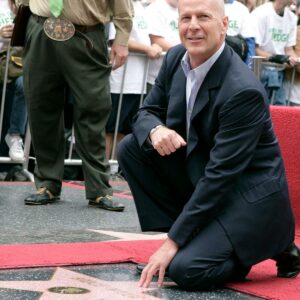Brad Pitt’s career arc is one of the most captivating transformations in the history of Hollywood. From his early days as the quintessential heartthrob in romantic comedies to his rise as a serious, versatile actor capable of taking on complex dramatic roles, Pitt’s journey stands as a testament to the power of reinvention and growth within the entertainment industry. This article delves into how the actor evolved, the strategic decisions behind his career choices, and how his shifts in roles have ultimately redefined him as one of Hollywood’s most respected talents.
1. The Early Years: A Rising Star in Romantic Comedies
Brad Pitt first emerged on the Hollywood scene with a golden combination of charm, good looks, and undeniable charisma. His breakout role in Ridley Scott’s Thelma & Louise (1991) may have been brief, but it left an indelible mark on the film industry and solidified him as a leading man in the making. As Jodie Foster’s coy and confident hitchhiker, Pitt radiated sex appeal and a magnetic energy that catapulted him into the public consciousness. This moment proved to be pivotal, marking the start of a meteoric rise that would soon see him become one of the most sought-after actors in the world.
However, it was his subsequent work in romantic dramas and comedies that truly made him a household name. In Legends of the Fall (1994), Pitt embodied Tristan Ludlow, the tortured, romantic hero in a sweeping epic that showcased both his raw physicality and emotional depth. The film became a box office success, with Pitt’s performance capturing the hearts of audiences who found themselves enamored with his portrayal of a man struggling with love, loss, and the weight of familial duty. It was a role that would cement his place as a heartthrob.
In the late 1990s, Pitt continued his streak of romantic roles, appearing in Meet Joe Black (1998) and Seven Years in Tibet (1997), films that leaned heavily on themes of love, self-discovery, and spiritual growth. His role in Meet Joe Black, where he portrayed the embodiment of Death, showcased his ability to play the charming yet somewhat ethereal character, balancing light-hearted moments with deeper, more existential themes. While these films were generally well-received, they also reinforced Pitt’s image as a leading man known more for his good looks and romantic entanglements than for the depth of his acting.
Despite the immense popularity he garnered from these roles, Pitt, like many actors early in their careers, faced the looming risk of being typecast. The question that would define his future in Hollywood was whether or not he could break free from the trappings of the romantic leading man and prove himself as an actor capable of a broader range of roles.
2. The Pivot: Seeking Greater Depth and Variety
By the end of the 1990s, Brad Pitt began to grapple with the limitations of his established persona. He recognized the need to challenge himself artistically and stretch his capabilities beyond the surface-level romantic roles that had initially made him famous. His early career had shown that he could effortlessly captivate an audience with his good looks and undeniable charm, but to be considered more than just a heartthrob, he needed to take on more demanding and unconventional roles.
It was during this period that Pitt began his pivot into more complex, dramatic territory. Determined to break free from typecasting, he sought out roles that offered more psychological depth and emotional weight. He was no longer content with being simply the “pretty boy” of Hollywood; he wanted to prove himself as an actor with real range. This quest for growth and diversification of his craft would set the stage for a remarkable transformation in his career.
Pitt’s decision to work with acclaimed directors in genres that challenged his previous image was a bold one. But it was the quality of his performances in these new ventures that would ultimately define his reinvention.
3. Landmark Roles in Serious Drama
Pitt’s foray into more serious, dramatic roles began with films that balanced dark humor with deeper philosophical themes. One of the key turning points in this transition came with the release of Fight Club (1999), directed by David Fincher. In this film, Pitt portrayed Tyler Durden, a charismatic, anarchistic figure who guides the narrator (played by Edward Norton) through a journey of self-destruction. Fight Club was a film that blended psychological exploration with social commentary, and Pitt’s performance was a revelation. He was no longer simply the romantic lead, but rather an actor who could delve into the psyche of a character with disturbing intensity.
Although Fight Club was a polarizing film upon its initial release, it has since become a cult classic, largely due to Pitt’s electric performance. This role signaled a dramatic shift in his career—one where he embraced darker, more nuanced characters. It was here that the actor’s depth as a performer truly began to surface.
In Snatch (2000), a fast-paced, crime-laden comedy directed by Guy Ritchie, Pitt again defied expectations by taking on the role of a quirky, almost cartoonish boxer with a thick Irish accent. While this character was more comedic than his previous work, Pitt’s ability to master the intricacies of this offbeat role showcased his adaptability. It wasn’t just his chiseled looks and charm anymore; it was his capacity to fully inhabit a diverse range of characters.
Yet, the performance that marked his true breakthrough into serious drama came in 1995 with 12 Monkeys, directed by Terry Gilliam. In this film, Pitt portrayed Jeffrey Goines, a mentally unstable man caught in a dystopian time-travel narrative. His portrayal was mesmerizing, earning him his first Golden Globe Award and widespread critical acclaim. The role demanded not only a deep dive into a character’s madness but also a nuanced approach to portraying a man grappling with reality and his role in a catastrophic future.
4. Winning Accolades and Recognition
Brad Pitt’s move into dramatic cinema continued to pay dividends in the 2000s. His dedication to exploring more profound and varied roles earned him a reputation as an actor of considerable skill and range. His performance in The Curious Case of Benjamin Button (2008) stands out as a particularly transformative moment in his career. In this film, Pitt portrayed Benjamin Button, a man who ages in reverse. The role required him to navigate an emotionally complex journey of love, loss, and the passage of time, and Pitt’s performance was lauded for its subtlety and depth. The film earned him an Academy Award nomination for Best Actor, cementing his status as a serious contender in Hollywood’s elite acting ranks.
However, it was in Moneyball (2011) and 12 Years a Slave (2013) that Pitt’s evolution truly reached its apex. In Moneyball, Pitt portrayed Billy Beane, the general manager of the Oakland Athletics, who revolutionized baseball with his analytics-based approach to team-building. Pitt’s portrayal of Beane’s quiet desperation and his determination to succeed despite overwhelming odds earned him widespread acclaim. His performance in 12 Years a Slave, though in a smaller supporting role, further solidified his transition into serious drama. The film won the Academy Award for Best Picture, and Pitt’s involvement as a producer and actor reinforced his dual role in shaping the story of the film.
By the time he starred in Once Upon a Time in Hollywood (2019), a film that earned him his first Academy Award for Best Supporting Actor, Brad Pitt had fully evolved from the romantic lead into a seasoned actor known for his nuanced performances across a wide range of genres. His portrayal of Cliff Booth, a laid-back stuntman in 1969 Hollywood, was both lighthearted and deeply affecting, demonstrating his mastery of both drama and comedy.
5. The Evolution of Brad Pitt
Today, Brad Pitt stands as one of the most respected actors in Hollywood, a far cry from the young heartthrob who first graced the screen in Thelma & Louise. His career journey—from romantic comedies to complex, dramatic roles—has been marked by a constant desire for artistic growth and a willingness to take risks. He has proven that he is not just a pretty face, but an actor who can bring emotional complexity, authenticity, and depth to any role he plays.
Furthermore, Brad Pitt has established himself as a producer with his production company, Plan B Entertainment, which has been behind several critically acclaimed films, including 12 Years a Slave, The Big Short (2015), and Moonlight (2016). As a producer, Pitt has continued to champion stories that explore complex human experiences, further solidifying his position as a multifaceted figure in the industry.
Pitt’s evolution as an actor reflects his growth as a person, an artist, and a public figure. His willingness to break free from the constraints of his early career and explore new territory has allowed him to craft a legacy that is as impressive as it is diverse. Today, Brad Pitt is not only a symbol of Hollywood stardom, but also a testament to the power of reinvention, resilience, and artistic ambition.
In the end, Brad Pitt’s transition from romantic comedies to serious drama is more than just a career shift—it is a story of transformation and artistic maturation, one that has redefined his place in Hollywood history. His ability to evolve, adapt, and tackle a wide array of challenging roles has ensured that his legacy as one of the finest actors of his generation will endure for years to come.





